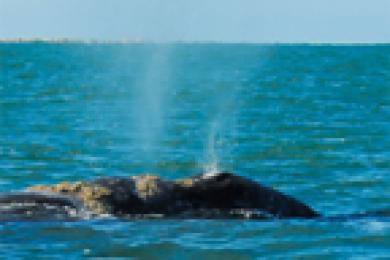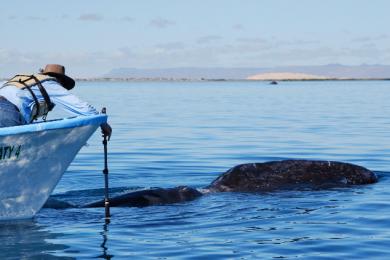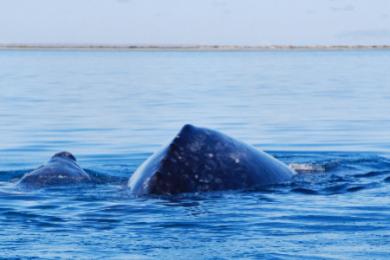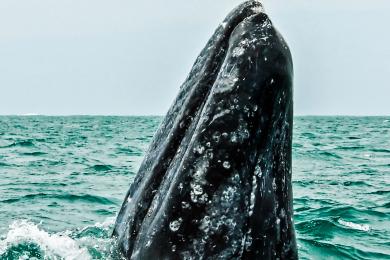Gray Whale Migration
By late November, most whales are moving southward from summer feeding areas (Chukchi, Beaufort, and the northwestern Bering Seas) to winter calving areas (the west coast of Baja California, Mexico, and the southeastern Sea of Cortez). The northward migration begins about mid-February and most whales arrive to the summer feeding grounds between May and June. The best viewing time at Pigeon Point is in the spring.
The month of February is considered an overlap month in the gray whale migration, as the last few whales are heading south to Baja and the first few whales are beginning to head north. February and March are typically peak months for numbers of gray whales in the Baja lagoons.
Migrating gray whales move steadily in one direction, breathing and diving in predictable patterns. They commonly travel alone or in small groups, although large groups can occur in both the feeding and breeding grounds. Except for mother-calf pairs, associations between individuals are relatively fluid.
The gray whale migration is one of the longest annual migrations of any mammal, as they travel 6000 miles each way.
Hunted to Near Extinction – Mexico Protected Gray Whales
The gray whales are an incredible story of survival, as they have rebounded from near extinction. These huge marine mammals were extensively hunted for their blubber, which was made into oil. The whalers often hunted the gray whales in the lagoons of Baja Mexico, where the whales come to mate and give birth. During those dark days of whaling in the Baja lagoons, the whales were called “Devilfish,” as they were known to smash up the boats of the whalers (in all likelihood attempting to protect themselves and their young from harpoons!). By the late 1940’s, the gray whale population was thought to be down to about 1000 animals. In 1946, Mexico passed legislation to prohibit any killing of gray whales off its coast and, during the 1970’s and 80’s, Mexico further protected the gray whales by establishing sanctuaries (or marine protected areas) in the lagoons of Ojo de Liebre, Guerrero Negro, and San Ignacio. Today, about 18,000 gray whales migrate along our coast. The gray whales were removed from the U.S. endangered species list in 1994. Given this past history of human exploitation, it is remarkable that there are gray whales called “friendlies” in the Baja lagoons. Often, a mother gray whale will bring her newborn calf right up alongside small boats, to the delight and awe of the humans in the boats!
Docent Volunteers at Pigeon Point Light Station
Beginning in March, after the northbound migration gets into full swing, Docents are stationed at the observation deck from Friday to Monday. The peak of the gray whale watching season is typically April, but gray whales moving northward are often seen throughout May. Docents at the light station focus on marine mammal interpretation, and they are passionate about whales and sharing information with visitors. If you go out to the deck, you will find a very knowledgeable docent who has likely set up an interpretive display about gray whales. He or she will be very excited and happy to help you try to spot a whale.
Whale Watching Tips
Now it’s your turn to look for a blow! To spot a gray whale, scan the horizon. Look for a high, bushy, heart- (or V-) shaped blow up to 15 feet high. The whale’s fluke (tail) will often be lifted out of the water prior to a deep dive. They don’t really have a dorsal fin, rather a dorsal “hump” followed by a series of 6-12 inch “knuckles.” The flippers are relatively short and paddle shaped, with rounded margins and pointed tips. The flukes are broad, often spanning more than 9 feet. Adult gray whales are about 35-50 feet long and weigh just shy of 100,000 pounds. Once you spot the blow, watch for a pattern of breathing and diving; then, grab your binoculars for a closer look.
The cove on the south side of the deck is a particularly good place to spot migrating female gray whales with their calves. They swim side by side, and they often come partway into the cove and around the rock right beside the observation deck. The cove is a particularly advantageous whale-watching spot, as you can see the whale moving directly towards the deck; this provides the whale watcher with the unusual opportunity to see a gray whale from the FRONT (rather than the side). If this is the case, you may be fortunate enough to see the heart-shaped blow!
Many visitors wonder when the best time is to see a whale. Nancy Frost, a docent at the light station explains, “There is no perfect time, as whales are constantly on the move (24 hours a day) and it’s possible to see a whale on any day at any time! It just depends on if you are there at the time the whales are there!“ To have the best chance of seeing a whale, Nancy recommends that you plan to spend the day at Pigeon Point. Dress warmly and bring a lunch, snacks, sunscreen and, of course, don’t forget your binoculars. Even if you don’t see a whale, plenty of other marine life is in the area to view--harbor seals, oystercatchers, gulls, pelicans, pigeon guillemots, to name a few.
Visitors may also see the occasional humpback whale or blue whale from the observation deck. These types of whales are more common along our coast in the summer, but you never know what you might spot from the deck. The humpback whales can offer some of the best sightings, as they often breach (throw their bodies out of the water) or slap their flukes, much to the thrill of the whale watchers. Or you may be lucky enough to spot the world’s largest mammal, the blue whale. One day, a docent spotted three blue whales just off the observation deck!
Whale watching can be a very moving experience. One day a woman visitor saw her first whale, a baby gray whale, spyhop (or put its head of the water) right by the deck. The docent turned to ask the woman if she had seen the whale and the woman had tears of joy rolling down her cheeks! The volunteers at the lighthouse would love to have you share the experience of whale watching with them, whether you are looking for your first or 1000th whale!





